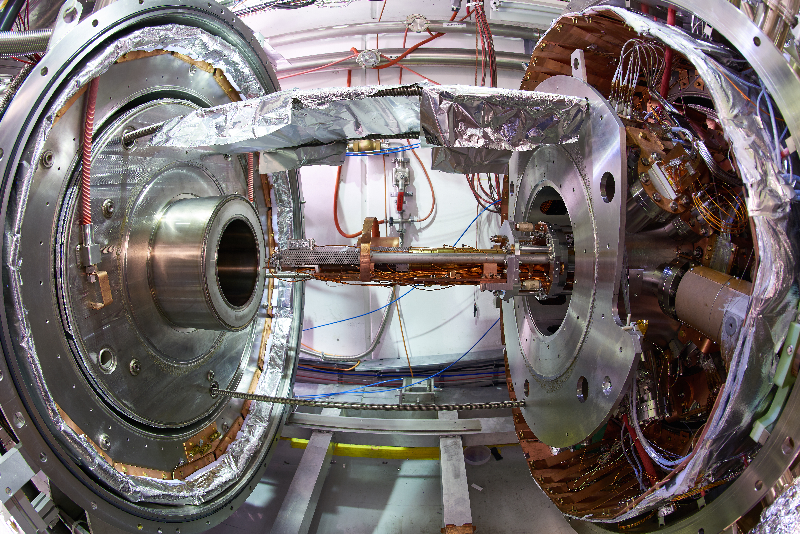Cooling on the Negative Side
Cooling atoms and ions to near absolute zero may seem routine, but surprisingly, negatively charged ions are hard to cool down even to room temperature. Researchers have now demonstrated a technique for cooling negative ions by discarding the warmest ones from the group. Further refinement of this strategy could offer a way to generate cold antimatter, which researchers would like to use to test for alternative theories of gravity.
Using an extensive toolbox of cooling techniques, physicists routinely trap and chill atoms and positively charged ions to temperatures below 1 K (“subkelvin” temperatures), where they can be used as precision clocks or quantum bits. By contrast, negatively charged ions, or “anions,” have been immune to these cooling methods. Researchers have used less efficient techniques, such as electron cooling—where anions interact with a cold electron plasma—but the coldest temperatures have been only about 4 K. Methods that can reach lower anion temperatures would benefit studies of chemical reactions in space, and colder anions could also cool antiprotons for antimatter experiments.
The challenge is that “anions are quite fragile,” says Alban Kellerbauer from the Max Planck Institute for Nuclear Physics in Germany. A negative ion is an atom with an added electron, which the atom can easily let go of. As a result, most anions cannot be put into a stable excited state by absorbing a photon; instead, photons simply knock out the extra electron. This fragility makes most anions ineligible for Doppler cooling, a highly efficient cooling method in which atoms are repeatedly excited by photons.
To make progress, Kellerbauer and his colleagues have turned to evaporative cooling, which has long been used by atomic physicists. It works by removing the hottest particles from a trap, so that the remaining gas becomes colder. The traditional technique has not been used for negative ions because they typically start off too hot (around 10,000 K) and would lose far too many ions in the process.
The team’s laser-assisted evaporative cooling method—proposed nearly 30 years ago [1]—capitalizes on the fragility of anions. The extra electron in an anion is easily stripped by a laser, and once this stripping occurs, the now-neutral atom can escape from the electric fields that constitute the trap. To target hot ions for this liberation, the team focused their laser a short distance from the trap center. That off-center location is reached mainly by the most energetic ions, which are the ones able to stray far enough from the trap center. The team tested their method on a gas of negatively charged oxygen ions. Starting at an initial temperature of 13,000 K, the gas was cooled to 3800 K in about 100 seconds. By the end, between 10% and 30% of the original population remained.
The final temperature is still hot, but Kellerbauer says that the new technique opens up a multistep pathway to subkelvin anions. The scheme would require using one of the few anions that has multiple electron levels, and lanthanum is considered the best option. The ion trap used by Kellerbauer’s team could not accommodate lanthanum ions, but they are currently redesigning their trap for that purpose. They are also exploring ways to optimize their evaporative cooling technique with a second laser that would improve the selectivity of the electron-stripping process.
The team’s aim is to pre-cool lanthanum ions to 100 K. At that point, calculations have shown that Doppler cooling could be used to further cool the lanthanum ions to microkelvin temperatures [2, 3]. This subkelvin anion gas could chill a cloud of antiprotons to near absolute zero if the two gases were mixed together. The resulting cold antiprotons could then be combined with positrons to make cold antihydrogen, which a number of experiments—such as AEgIS—require for testing whether antimatter falls at the same rate in response to Earth’s gravity as normal matter.
“This study is an important advance for laser cooling of negatively charged species,” says Wesley Walter from Denison University in Ohio, who specializes in negative ion research. “Although the degree of cooling achieved in this study is modest, it’s the first demonstration of a technique that provides a step toward reaching ultracold temperatures.” Atomic physicist Michael Charlton from Swansea University in the UK also sees this work as “an important first step” in the pre-cooling of anions towards the eventual goal of producing cold antihydrogen for gravity investigations.
This research is published in Physical Review Letters.
–Michael Schirber
Michael Schirber is a Corresponding Editor for Physics Magazine based in Lyon, France.
References
- A. Crubellier, “Theory of laser evaporative cooling of trapped negative ions. I. Harmonically bound ions and RF traps,” J. Phys. B 23, 3585 (1990).
- C. Walter, N. Gibson, D. Matyas, C. Crocker, K. Dungan, B. Matola, and J. Rohlén, “Candidate for laser cooling of a negative ion: Observations of bound-bound transitions in La−,” Phys. Rev. Lett. 113, 063001 (2014).
- G. Cerchiari, A. Kellerbauer, M. Safronova, U. Safronova, and P. Yzombard, “Ultracold anions for high-precision antihydrogen experiments,” Phys. Rev. Lett. 120, 133205 (2018).





